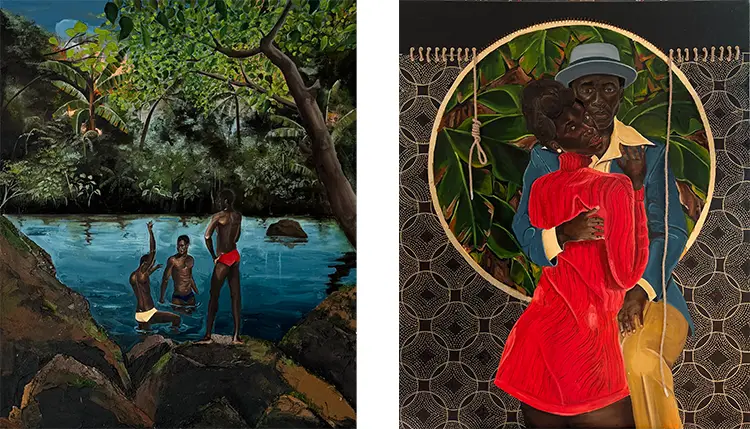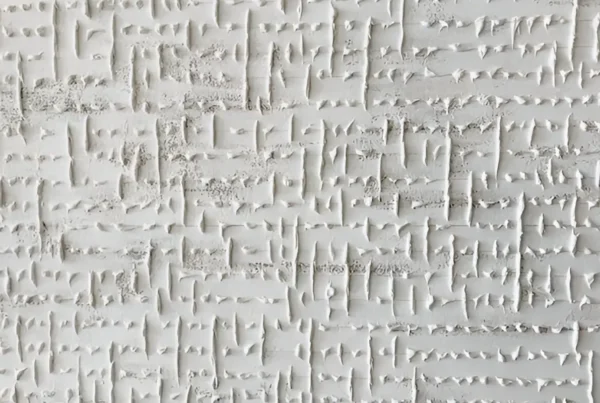“My work seeks to reflect, question, and celebrate the Black experience through visual storytelling.”
Fragments Reclaimed: A Return to the Canvas
Emerging from a long silence marked by scientific pursuits and professional detours, Richard Mensah re-entered the art world not as a newcomer, but as someone reclaiming a language that had always been his. Born in Ghana and now based in the UK, Mensah’s path defies linear storytelling. His creative instincts were apparent from a young age, but societal expectations steered him toward engineering. The shift did not sever his connection to art—it merely paused it. In 2017, after fifteen years away from the brush, a force within reawakened, drawing him back with undeniable urgency. That year was not simply a return; it was a reawakening, one that marked the true start of his professional journey and a reclamation of a voice that had always lingered beneath the surface.
Mensah’s identity as a self-taught artist significantly shapes his process and outcomes. With no formal instruction to mold his approach, his style evolved organically, unbound by convention or institutional technique. This freedom translates into an artistic voice that is raw yet refined, instinctive yet purposeful. Each piece he creates carries the imprint of someone who has taught himself not just how to paint, but how to see—how to interpret memory, emotion, and social experience through a visual lens. His time spent in science and engineering, rather than stifling creativity, has lent his art an added layer of depth, encouraging a structured yet fluid engagement with form and meaning.
The transition from engineering to art was not just a career pivot—it was a reclamation of identity. Mensah didn’t step into the art world to adopt a new persona; he returned to recover an old one. His rediscovery of painting after years of technical focus serves as a powerful testament to the durability of passion and the inexorable pull of creative purpose. It’s a story of reconnection—not just with paint and canvas, but with self-expression, cultural commentary, and a desire to communicate experiences that transcend words. Art, for Mensah, became both compass and mirror—a way to navigate personal history and hold it up for communal reflection.
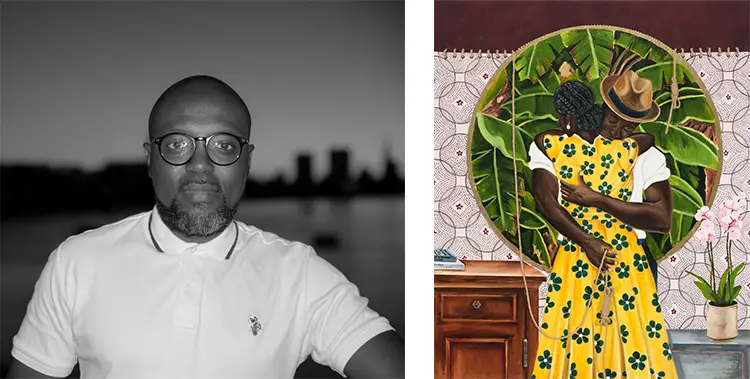
Richard Mensah: Narratives in Motion and Stillness
Mensah’s style resists easy classification, flowing between abstraction and realism with a confidence that reflects his intuitive approach. Rather than beginning with detailed sketches or strict concepts, he embraces spontaneity. The process often starts with a single thought or feeling, allowing instinct to take the lead. His fascination with movement, shape, light, and tone transforms his canvases into dynamic spaces where form and emotion coexist. This allows his work to maintain a certain tension—where clarity and ambiguity enhance, rather than obscure, the message. Through this balance, Mensah invites viewers into an emotional dialogue that feels personal yet universally resonant.
Themes in Mensah’s work are heavily anchored in the Black experience, both historical and contemporary. His paintings navigate complex social and cultural terrains—grappling with systemic inequality, heritage, and resilience. A recurring subject in his portfolio is the erasure of Black presence in shared public spaces, including references to the historical exclusion from swimming pools and similar institutions. At the same time, he celebrates the cultural renaissance flourishing within Black communities. By channeling both injustice and triumph into his pieces, Mensah acts as both a chronicler and a catalyst—using art to ask questions, provoke thought, and affirm identity.
One of Mensah’s most impactful works, Taken, exemplifies this commitment to socially charged storytelling. The painting emerged from a deeply personal encounter—a police stop-and-search incident that left him feeling dehumanized and profiled. This moment of vulnerability and confrontation transformed into a powerful visual statement. Completed during the global outcry following George Floyd’s death, Taken became not only a personal catharsis but also a communal reckoning. It confronts the viewer with the harsh realities of racial profiling while offering a poignant exploration of fear, dignity, and resistance. The synchronicity of its creation with worldwide protests infused it with added urgency and emotional weight.
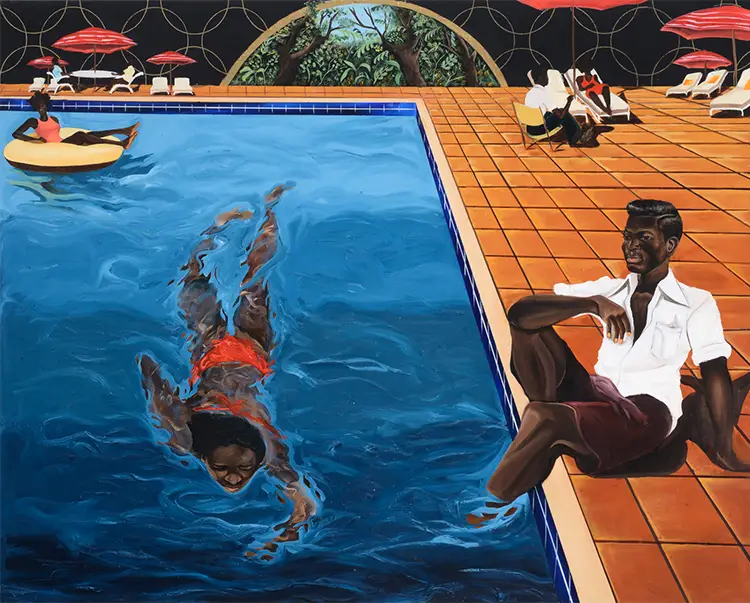
Between Surface and Substance
Materials play a crucial role in how Mensah articulates meaning. While oil paint remains his primary medium—chosen for its richness, versatility, and depth—he continually experiments with other materials that add tactile complexity to his compositions. Incorporating fabric, leather, rope, sandpaper, and modeling paste, he crafts multi-dimensional works that engage the senses beyond sight. These mixed media explorations not only expand the physicality of his art but also mirror the layered nature of the themes he explores. The textures often function as metaphors, reflecting the friction, resilience, and multiplicity embedded in cultural identity and personal history.
Mensah’s creative environment is designed to sustain intense focus and immersion. His studio is a sanctuary where distractions are deliberately shut out. With essential tools at hand—paints, brushes, palette knives, and chosen surfaces—he enters a mental space where art and emotion intertwine seamlessly. Music and audiobooks accompany his process, not as background noise, but as mood-setters that influence rhythm and tone. This environment allows him to remain fully absorbed in the work, enabling a state where ideas can unfold organically without external disruption. The isolation is not avoidance but commitment: a deep respect for the process of storytelling through visual means.
The artist’s openness to influence extends far beyond the confines of galleries and studios. While he acknowledges the impact of numerous artists, his primary sources of inspiration are often found in lived experiences and history. Cultural shifts, personal encounters, and the weight of shared memory inform his creative choices. His work responds to the world around him, translating observation into narrative. Rather than mimic or reference other artists overtly, he absorbs a broader human context—allowing the urgency, tension, and hope found in everyday life to shape each piece. His art becomes a conduit through which collective memory is reframed and re-expressed.
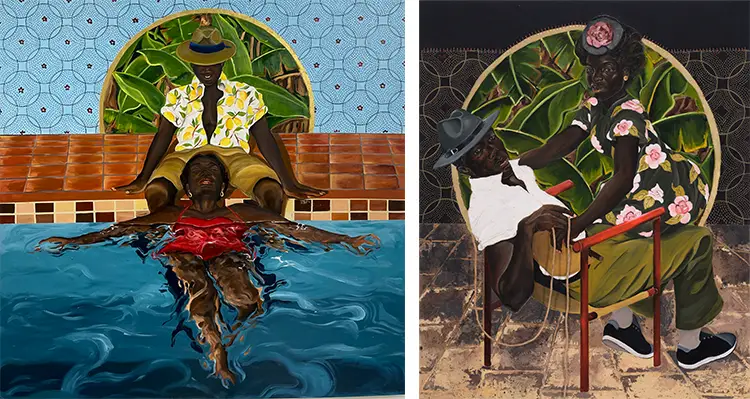
Richard Mensah: Echoes of the Ashanti Drum
Among Mensah’s most ambitious aspirations lies a concept rooted in heritage and cultural introspection—an immersive exhibition dedicated to the Ashanti funeral tradition. Far from a morbid investigation, the project aims to explore the vibrant and ceremonial aspects of death within Ghanaian culture. Through a curated fusion of paintings, installations, and live performances, the exhibition would serve as an educational and emotional journey, inviting audiences to experience a perspective on mortality that emphasizes celebration, respect, and communal memory. The project’s multidimensional format reflects Mensah’s belief in art as a living, breathing dialogue between creator and community.
This envisioned showcase goes beyond typical gallery presentation. By incorporating live performance and installation art, Mensah seeks to recreate the sensory and symbolic atmosphere of an Ashanti funeral—not as spectacle, but as a cultural narrative that demands attention and reverence. Visitors would not simply view art; they would move through it, feel its weight, and perhaps, be transformed by its rhythms and meanings. This immersive approach echoes his broader artistic philosophy: that art should not be passively consumed but actively experienced. His aim is to spark conversations around grief, identity, and continuity—how life and death intertwine in ways both personal and collective.
For Mensah, the Ashanti project is more than artistic ambition—it’s an act of cultural preservation and reinterpretation. In sharing these rituals with new audiences, he hopes to challenge preconceived notions about African traditions and foster a deeper understanding of the values embedded within them. The project also reflects his ongoing commitment to bridging his Ghanaian roots with his present-day experiences in the UK. By reimagining the Ashanti funeral as an immersive narrative, Mensah offers not only a tribute to his heritage but also an invitation for cross-cultural engagement—a moment where art becomes the bridge between generations, continents, and perspectives.
